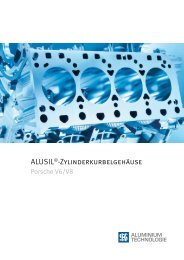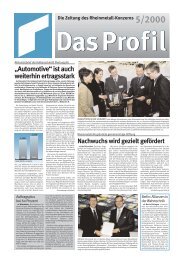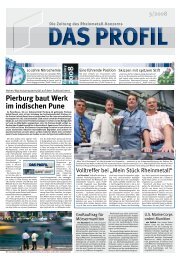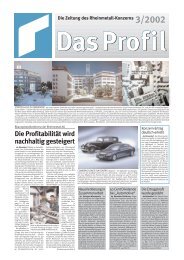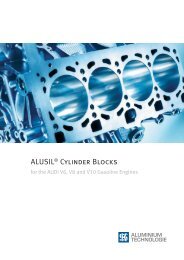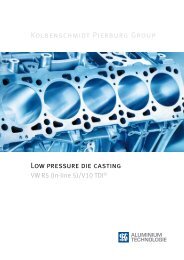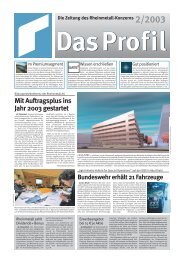PDF [2.1 MB] - KSPG AG
PDF [2.1 MB] - KSPG AG
PDF [2.1 MB] - KSPG AG
You also want an ePaper? Increase the reach of your titles
YUMPU automatically turns print PDFs into web optimized ePapers that Google loves.
Unterlüß. EADS/LFK (Lenkflugkörper)<br />
are carrying out mechanical<br />
and electronic modification<br />
work on the radar unit of the<br />
Patriot weapon system as part of<br />
the ongoing capability upgrade<br />
program. With mechanical modifications<br />
complete and new functional<br />
components installed in Unterschleißheim,<br />
the system is now<br />
being taken into operation stepwise.<br />
To this end, the individual<br />
functional areas are being adjusted<br />
to one another in a test station<br />
in Unterschleißheim, parameters<br />
are being set, performance data<br />
verified and parameters readjusted<br />
as necessary.<br />
When this phase has been completed,<br />
the radar unit will be transported<br />
to Unterlüß where it will initially<br />
be subjected to thermal tests,<br />
including the exposure to extreme<br />
hot and cold conditions in the temperature<br />
test system. Such tests<br />
serve to identify and replace temperature-sensitive<br />
assemblies in order<br />
to warrant the proper function<br />
of the radar unit when operated under<br />
extreme climatic conditions.<br />
EADS tests<br />
Patriot radar<br />
Thermal tests will be followed by<br />
performance tests. Based on the<br />
requirements of the customer and<br />
in cooperation with Rheinmetall,<br />
an active measurement route has<br />
been set up at the fire position<br />
East, the related infrastructure being<br />
provided by the experts from<br />
the test center in Unterlüß. The<br />
measurement route is being used<br />
to simulate – with the aid of a simulator<br />
– defined targets and interference<br />
signals via two parabolic<br />
antennas on mobile mast systems<br />
for the radar unit and to „feed“<br />
these into the unit via an air route.<br />
Subsequent evaluations will be<br />
carried out with a test station.<br />
Once tests have been completed<br />
and the proper function has been<br />
demonstrated, EADS/LFK will hand<br />
over the radar unit to the customer<br />
(Federal Office for Defence Technology<br />
and Procurement) and the<br />
user (German Air Force) in Unterlüß.<br />
The project is a good example<br />
of the excellent cooperation between<br />
different manufacturers at<br />
Unterlüß.<br />
Newsline<br />
EZU test center has a lot to offer<br />
Serving the military<br />
and the civil sector<br />
(Continued from page 9)<br />
measurements taken will supply the<br />
answer to the last question as each<br />
chamber has an opening to the main<br />
firing range. Commenting on the special<br />
temperature test facility, Lunkeit<br />
points out: “We measure whether the<br />
accuracy of firing changes at extreme<br />
temperatures.”<br />
New tasks of the armed forces in the<br />
light of force transformation activities<br />
can also be simulated at the EZU. Since<br />
the rapid reaction forces can be assigned<br />
to locations worldwide and not<br />
just in Europe, solar simulations can be<br />
performed with an irradiation of up to<br />
1,200 W per square meter. Quite a few<br />
armored tracked and wheeled vehicles<br />
have felt the hot and cold – for instance,<br />
the refueling vehicle for an unmanned<br />
KZO reconnaissance<br />
air<br />
vehicle that was<br />
recently tested at<br />
Unterlüß on behalf<br />
of Rheinmetall Defence<br />
Electronics.<br />
A coat of ice covers<br />
the camouflage<br />
paint, and people<br />
exposed to the<br />
freezing temperatures<br />
inside the<br />
test facility have to<br />
wear protective<br />
clothing to withstand<br />
the cold.<br />
Extreme heat can<br />
obviously be just<br />
as merciless: The<br />
chambers can be<br />
heated up to 85°C<br />
with 95% humidity.<br />
Can soldiers actually<br />
survive under<br />
such conditions?<br />
Again, the engineers at the EZU<br />
will supply the answer. “Various customers<br />
test their vehicles with the<br />
crews,” says Lunkeit. This is done because<br />
of NATO’s so-called out-of-area<br />
missions. Wired up to the measurement<br />
systems just like the working<br />
places are, the soldiers in the test system<br />
then either have to sweat or shiver<br />
– a doctor always being nearby.<br />
10<br />
A view inside the temperature test facility:<br />
a Leopard main battle tank is exposed<br />
to solar simulation – the irradiator<br />
has an output of up to 1,200 W/m 2 .<br />
The rooms of the temperature test facility<br />
are packed full with measuring instruments.<br />
Lunkeit points out: “Customers<br />
like the German Army or manufacturers<br />
from other countries can naturally<br />
also bring their own measuring<br />
equipment.” This flexibility and the<br />
wide range of tests help to ensure that<br />
the temperature test facility is used<br />
throughout the year. The Patriot missile<br />
system from EADS (see box on this<br />
page), the German Leopard main battle<br />
tank, the self-propelled howitzer 2000,<br />
vehicles from the Dutch army, British<br />
armored recovery vehicles – they have<br />
also visited the temperature test facility<br />
in Unterlüß.<br />
Even road cleaning vehicles have<br />
been “boiled” in the heat, the German<br />
Association for Technical Inspection<br />
(TÜV) has tested car seats, ticket machines<br />
fabricated<br />
by Höft & Wessel<br />
have had to freeze<br />
and so have helicopters.<br />
“If things<br />
continue the way<br />
they are, we will<br />
have to extend the<br />
facilities,” says<br />
Lunkeit with obvious<br />
delight. The<br />
extreme conditions<br />
bring faults<br />
to light that simply<br />
were not evident at<br />
the drawing board<br />
– like the extinguishant<br />
from a<br />
fire engine which<br />
simply froze in the<br />
cold (this problem<br />
was resolved by fitting<br />
a heating system<br />
in the steel<br />
tube). Explaining<br />
the business policy<br />
of the EZU, Lunkeit remarks: “The<br />
core competencies from the military<br />
sector are now being used to win new<br />
customers from the civil sector.”<br />
The vibration test system is suitable<br />
for both military and civil applications.<br />
The basic shape of the massive concrete<br />
building which looks a bit like a<br />
trapeze is an obvious reminder of the<br />
(Continued on page 12)


![PDF [2.1 MB] - KSPG AG](https://img.yumpu.com/4218313/10/500x640/pdf-21-mb-kspg-ag.jpg)
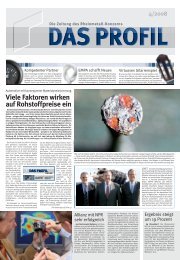
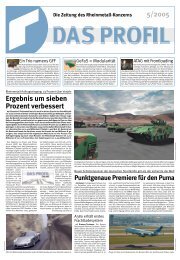
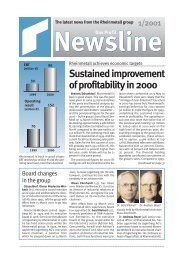

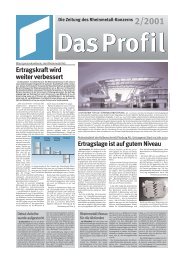
![PDF [1.0 MB] - KSPG AG](https://img.yumpu.com/5513074/1/171x260/pdf-10-mb-kspg-ag.jpg?quality=85)
